Crucial Developmental Genes Found to Still be Active in Adulthood
Hox genes play a critical role in the development of animal body plans. New research has shown that in planarians, this group of genes is also expressed in adulthood and is involved in asexual reproduction. The planarian flatworm can regrow parts of its body that are lost. They can even reproduce by pulling pieces of themselves off and growing a new animal. This work indicated that Hox genes are crucial to the regeneration process in planarians. The findings have been reported in Nature Communications.
While Hox genes are known to ensure that embryos form correctly along a head-to-tail axis, their role in planarians was still mysterious, noted lead study author Christopher Arnold, PhD, who works in the lab of Alejandro Sánchez Alvarado, PhD, a Howard Hughes Medical Institute investigator and chief scientific officer at the Stowers Institute for Medical Research.
The planarian model used by the Sánchez Alvarado lab is asexual, and lives in a permanent state of adulthood. Hox genes form segments in the anatomy of organisms, which the researchers discovered also occured in planarians. Thought to be non-segmented, when the planarians were pressed between coverslips, they popped apart into regularly spaced pieces. Those pieces were just like those that get pulled off of planarians to create a new animal.
These observations led the researchers to hypothesize that Hox genes are involved in asexual reproduction. Out of the thirteen Hox genes in their planarian model, five were found to be required for asexual reproduction. If Hox3 was deleted, for example, the resulting planarians had an excess of head to tail segments that were always trying to reproduce. If the post2b gene was removed, both the body segments and asexual reproduction were totally eliminated.
“We had found that Hox genes were not only functioning in adult animals, but they were also required for an exclusively adult animal activity like asexual reproduction,” said Arnold. The study suggested that genes that have been thought of as embryonic developmental genes may actually have other, unappreciated roles in adulthood and potentially, disease.
“It may be that our definition of what these genes are doing has been too narrow,” said senior study author Alejandro Sánchez Alvarado. “There may be a lot more that we have not discovered yet, and we just need to look in the right place.”
Sources: Stowers Institute for Medical Research, Nature Communications









